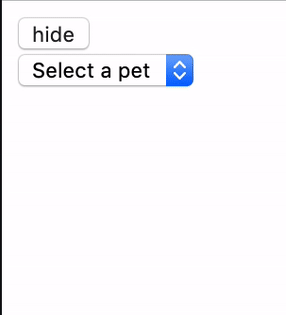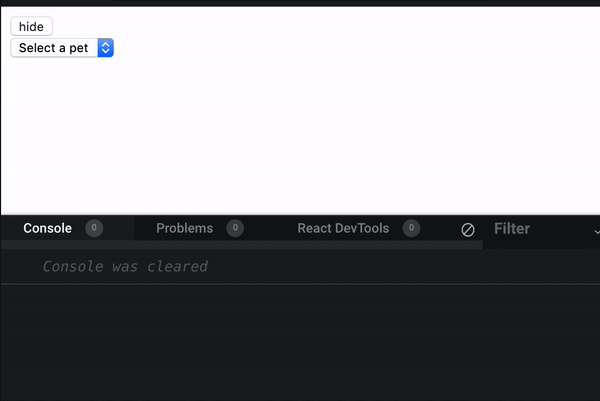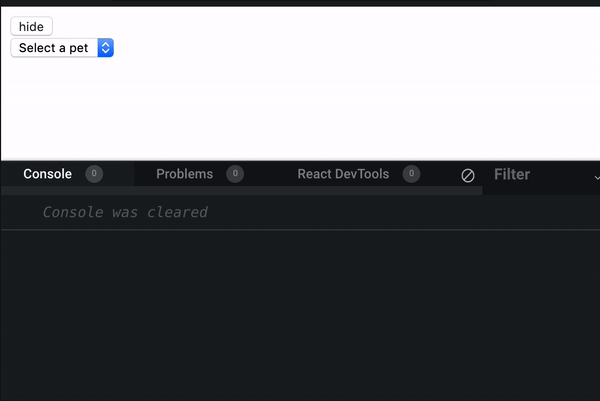React state update on an unmounted component
October 23, 2019 - 9 min read
If you are a react developer, there is a good chance that you faced this warning at least once:
Warning: Can’t perform a React state update on an unmounted component. This is a no-op, but it indicates a memory leak in your application. To fix, cancel all subscriptions and asynchronous tasks in a useEffect cleanup function.
In order to understand how to fix this warning, we need to understand why it is happening. We will need to reproduce it in a consistent way.
⚠️ Note that in this article i use react hooks, if you are using react class components you may see in the warning a reference to componentWillUnmount instead of the useEffect cleanup function.
Reproduce the warning
👀 I’ve uploaded a starter repo to github so you won’t have to copy paste the code. You can clone and run it locally or use the import feature of codesandbox.io
If we look at the warning again, we can see that there are 2 main parts playing a role here:
- A React state update
- An unmounted component
In order to create these, we will build this simple drop-down with asynchronous data fetching

State updates
function Pets() {
const [pets, dispatch] = useReducer(petsReducer, initialState);
const onChange = ({ target }) => {
dispatch({ type: "PET_SELECTED", payload: target.value });
};
useEffect(() => {
if (pets.selectedPet) {
dispatch({ type: "FETCH_PET" });
getPet(pets.selectedPet).then(data => {
dispatch({ type: "FETCH_PET_SUCCESS", payload: data });
});
} else {
dispatch({ type: "RESET" });
}
}, [pets.selectedPet]);
return (
<div>
<select value={pets.selectedPet} onChange={onChange}>
<option value="">Select a pet</option>
<option value="cats">Cats</option>
<option value="dogs">Dogs</option>
</select>
{pets.loading && <div>Loading...</div>}
{pets.petData && <Pet {...pets.petData} />}
</div>
);
}Here we have the Pets component, it uses the useReducer hook to store some state.
Lets see the petsReducer and the initial state:
const initialState = { loading: false, selectedPet: "", petData: null }
function petsReducer(state, action) {
switch (action.type) {
case "PET_SELECTED": {
return {
...state,
selectedPet: action.payload
};
}
case "FETCH_PET": {
return {
...state,
loading: true,
petData: null
};
}
case "FETCH_PET_SUCCESS": {
return {
...state,
loading: false,
petData: action.payload
};
}
case "RESET": {
return initialState;
}
default:
throw new Error( `Not supported action ${action.type}` );
}
}As you can see theres nothing special here, a simple reducer that manage our state.
The Pets component also use the useEffect hook for some side effects like fetching the data of our selected pet, we invoke the getPet function which returns a Promise and we dispatch the FETCH_PET_SUCCESS action with the returned data as the payload to update our state.
Note that getPet is not really hitting a server end-point, its just a function that simulate a server call. This is how it looks like:
const petsDB = {
dogs: { name: "Dogs", voice: "Woof!", avatar: "🐶" },
cats: { name: "Cats", voice: "Miauuu", avatar: "🐱" }
};
export function getPet(type) {
return new Promise(resolve => {
// simulate a fetch call
setTimeout(() => {
resolve(petsDB[type]);
}, 1000);
});
}As you see, its nothing but a setTimeout inside a Promise .
Our App is basically just rendering this Pets component:
function App() {
return (
<div>
<Pets />
</div>
);
}Ok first part of our problem is accomplished, thats the React state update , now we need to create the 2nd part - An unmounted component .
Un-mounting a component
This is relatively easy to accomplish using a state and a conditional rendering, we will store a boolean flag at the App level and we will render the <Pets /> component accordingly while using a toggle button.
function App() {
const [showPets, setShowPets] = useState(true); const toggle = () => { setShowPets(state => !state); };
return (
<div>
<button onClick={toggle}>{showPets ? "hide" : "show"}</button> {showPets && <Pets />} </div>
);
}This is how our application should look like

Reproduction
Ok, now that we have both conditions for the warning to appear lets try it. If we look again at the warning:
Warning: Can’t perform a React state update on an unmounted component. This is a no-op, but it indicates a memory leak in your application. To fix, cancel all subscriptions and asynchronous tasks in a useEffect cleanup function.
Lets focus on this line here:
React state update on an unmounted component
If we select a pet, we know that it will take our getPet at least 1 second to return our data. After our data is returned we are updating the state, if we will un-mount the Pet component before that 1 second (before our data is received) we will trigger an update on an unmounted component.
So this is how you do it:
*If you can’t make it with a 1 second delay, try to increase the timeOut in the getPet function.

OK this is part one of our task, now we need to fix it.
The fix
You may be surprised but the fix for this issue is actually the easy part. React is providing a clear and a very helpful message, with a guidance to the solution:
To fix, cancel all subscriptions and asynchronous tasks in a useEffect cleanup function.
Well, we may not exactly subscribing to anything here, but we do have an asynchronous tasks, remember the getPet asynchronous function:
function Pets() {
const [pets, dispatch] = useReducer(petsReducer, initialState);
const onChange = ({ target }) => {
dispatch({ type: "PET_SELECTED", payload: target.value });
};
useEffect(() => {
if (pets.selectedPet) {
dispatch({ type: "FETCH_PET" });
getPet(pets.selectedPet).then(data => { dispatch({ type: "FETCH_PET_SUCCESS", payload: data }); }); } else {
dispatch({ type: "RESET" });
}
}, [pets.selectedPet]);
return (
<div>
<select value={pets.selectedPet} onChange={onChange}>
<option value="">Select a pet</option>
<option value="cats">Cats</option>
<option value="dogs">Dogs</option>
</select>
{pets.loading && <div>Loading...</div>}
{pets.petData && <Pet {...pets.petData} />}
</div>
);
}So basically we just need to NOT update the state in the callback if the component is not mounted already.
function Pets() {
const [pets, dispatch] = useReducer(petsReducer, initialState);
const onChange = ({ target }) => {
dispatch({ type: "PET_SELECTED", payload: target.value });
};
useEffect(() => {
let mounted = true; if (pets.selectedPet) {
dispatch({ type: "FETCH_PET" });
getPet(pets.selectedPet).then(data => {
if(mounted){ dispatch({ type: "FETCH_PET_SUCCESS", payload: data }); } });
} else {
dispatch({ type: "RESET" });
}
return () => mounted = false;
}, [pets.selectedPet]);
return (
<div>
<select value={pets.selectedPet} onChange={onChange}>
<option value="">Select a pet</option>
<option value="cats">Cats</option>
<option value="dogs">Dogs</option>
</select>
{pets.loading && <div>Loading...</div>}
{pets.petData && <Pet {...pets.petData} />}
</div>
);
}Every time our effect will run, we are setting a local variable mounted to true, we set it to false on the cleanup function of the effect (like suggested by react). And most importantly, we are updating the state if and only if that value is true, that is if the component is un-mounted meaning our variable is set to false, it wont enter the if block.
So this is it, we are no longer receiving the warning:

Bonus Tip
We set a local variable inside the useEffect scope, if we want to re-use this variable inside another useEffect we can use useRef, which is sort of a none rendering state for components.
For example:
function Pets() {
const [pets, dispatch] = useReducer(petsReducer, initialState);
const isMountedRef = useRef(null);
const onChange = ({ target }) => {
dispatch({ type: "PET_SELECTED", payload: target.value });
};
useEffect(() => {
isMountedRef.current = true; if (pets.selectedPet) {
dispatch({ type: "FETCH_PET" });
getPet(pets.selectedPet).then(data => {
if(isMountedRef.current){ dispatch({ type: "FETCH_PET_SUCCESS", payload: data }); } });
} else {
dispatch({ type: "RESET" });
}
return () => isMountedRef.current = false;
}, [pets.selectedPet]);
useEffect(() => {
// we can access isMountedRef.current here as well })
return (
<div>
<select value={pets.selectedPet} onChange={onChange}>
<option value="">Select a pet</option>
<option value="cats">Cats</option>
<option value="dogs">Dogs</option>
</select>
{pets.loading && <div>Loading...</div>}
{pets.petData && <Pet {...pets.petData} />}
</div>
);
}The great thing about hooks is that we can extract this tiny logic to a custom hook and reuse it across components. One possible implementation can be something like this:
function useIsMountedRef(){ const isMountedRef = useRef(null); useEffect(() => { isMountedRef.current = true; return () => isMountedRef.current = false; }); return isMountedRef;}
function Pets() {
const [pets, dispatch] = useReducer(petsReducer, initialState);
const isMountedRef = useIsMountedRef();
const onChange = ({ target }) => {
dispatch({ type: "PET_SELECTED", payload: target.value });
};
useEffect(() => {
if (pets.selectedPet) {
dispatch({ type: "FETCH_PET" });
getPet(pets.selectedPet).then(data => {
if(isMountedRef.current){ dispatch({ type: "FETCH_PET_SUCCESS", payload: data });
}
});
} else {
dispatch({ type: "RESET" });
}
}, [pets.selectedPet, isMountedRef]);
return (
<div>
<select value={pets.selectedPet} onChange={onChange}>
<option value="">Select a pet</option>
<option value="cats">Cats</option>
<option value="dogs">Dogs</option>
</select>
{pets.loading && <div>Loading...</div>}
{pets.petData && <Pet {...pets.petData} />}
</div>
);
}Custom useEffect
If we want to get real crazy with our hooks, we can create our own custom useEffect (or useLayoutEffect) which will provide us the “current status” of the effect:
function useAbortableEffect(effect, dependencies) {
const status = {}; // mutable status object
useEffect(() => {
status.aborted = false;
// pass the mutable object to the effect callback
// store the returned value for cleanup
const cleanUpFn = effect(status);
return () => {
// mutate the object to signal the consumer
// this effect is cleaning up
status.aborted = true;
if (typeof cleanUpFn === "function") {
// run the cleanup function
cleanUpFn();
}
};
}, [...dependencies]);
}And we will use it in our Pet component like this:
useAbortableEffect((status) => { if (pets.selectedPet) {
dispatch({ type: "FETCH_PET" });
getPet(pets.selectedPet).then(data => {
if(!status.aborted){ dispatch({ type: "FETCH_PET_SUCCESS", payload: data });
}
});
} else {
dispatch({ type: "RESET" });
}
}, [pets.selectedPet]);Note how our custom effect callback now accepts a status argument which is an object that contains an aborted boolean property. If it is set to true, that means our effect got cleaned and re-run (which means our dependencies are changed or the component was un-mounted).
I kind of like this pattern and i wish react useEffect would get us this behavior out of the box. I even created an RFC on the react repo for this if you want to comment, improve it or just up-vote with a like so it will have a better chance to get implemented..
Wrapping up
We saw how a simple component with an asynchronous state update may yield this common warning, think about all those components you have with a similar case. Make sure you check if the component is actually mounted before you perform a state update.
Hope you found this article helpful, if you have a different approach or any suggestions i would love to hear about them, you can tweet or DM me @sag1v. 🤓

